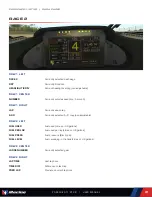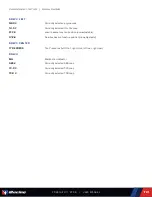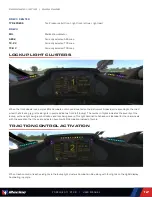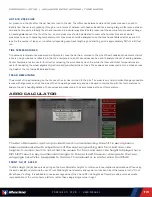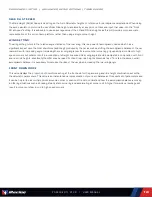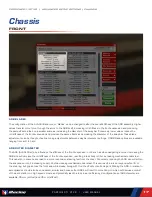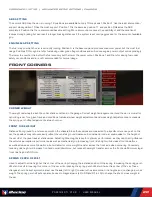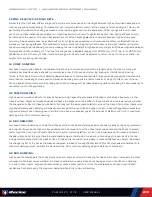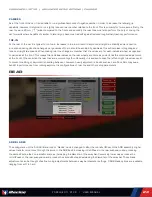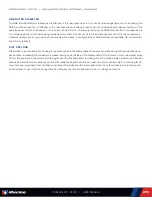
23
PORSCHE 911 GT3 R | USER MANUAL
SPRING SELECTED/SPRING RATE
Similar to at the front axle, stiffer springs will result in a smaller variance in ride height between high and low load cases and will
produce superior aerodynamic performance through improved platform control at the expense of mechanical grip. This can be
particularly prominent when exiting slow speed corners with aggressive throttle application. Stiffer springs will tend to react
poorly during these instances especially so on rough tracks which will result in significant traction loss. Spring stiffness should
be matched to the needs of the racetrack and set such that the handling balance is consistent between high and low speed
cornering. As an example case, a car which suffers from high speed understeer but low speed oversteer could benefit from an
increase in rear spring stiffness. This will allow for a lower static rear height which will reduce rear weight transfer during slow
speed cornering while maintaining or even increasing the rear ride height in high speed cornering to shift the aerodynamic balance
forwards and reduce understeer.11 options for spring rate are available ranging from 200 N/mm (1371 lbs/in) to 400 N/mm
(2286 lbs/in) in 20 N/mm (114 lbs/in) steps. Spring perch offsets must be adjusted to return the car to the prior static ride
heights after any spring rate change.
LS COMP DAMPING
Low speed compression affects how resistant the shock is to compresion (reduction in length) when the shock is moving at
relatively low speeds, usually in chassis movements as a result of driver input (steering, braking, & throttle) and cornering
forces. In this case -24 is minimum damping (least resistance to compression) while 0 is maximum damping (most resistance to
compression). Increasing the low speed compression damping will result in a faster transfer of weight to this corner of the car
during transient movements such as braking and direction change with increased damping usually increasing the cars tendency to
understeer on throttle application.
HS COMP DAMPING
High speed compression affects the shock’s behavior in high speed travel, usually attributed to curb strikes and bumps in the
track’s surface. Higher compression values will cause the suspension to be stiffer in these situations, while lower values will allow
the suspension to absorb these bumps better but may hurt the aerodynamic platform around the track. At smoother tracks more
high speed compression damping will typically increase performance while at rougher tracks or ones with aggressive kerbs less
high speed compression damping can result in an increase in mechanical grip at the expense of platform control. 0 is maximum
damping while -24 is minimum damping.
LS RBD DAMPING
Low speed rebound damping controls the stiffness of the shock while extending at lower speeds, typically during body movement
as a result of driver inputs. Higher rebound values will resist expansion of the shock, lower values will allow the shock to extend
faster. As at the front, high rebound stiffness will result in improved platform control for aerodynamic performance and overall
chassis response but it is important to avoid situations where the shock is too slow in rebounding as this can result in the tire
losing complete contact with the track surface. Provided this is avoided,, an increase in rebound stiffness can help to ‘slow down’
the change in pitch of the car as the brakes are applied, increasing braking stability and off-throttle mechanical understeer. 0 is
maximum damping (most resistant to extension) while -24 is minimum damping (least resistance to extension).
HS RBD DAMPING :
High-speed rebound adjusts the shock in extension over bumps and curb strikes. Higher values will reduce how quickly the shock
will expand, while lower values will allow the shock to extend more easily. Despite not having as much of an effect on handling
in result to driver inputs, High-speed rebound can produce similar results in terms of aerodynamic control and uncontrolled
oscillations if set improperly. 0 is maximum damping while -24 is minimum damping.
PORSCHE 911 GT3 R | ADVANCED SETUP OPTIONS | CHASSIS
Содержание Porsche 911 GT3 R
Страница 1: ...1 PORSCHE 911 GT3 R USER MANUAL...

